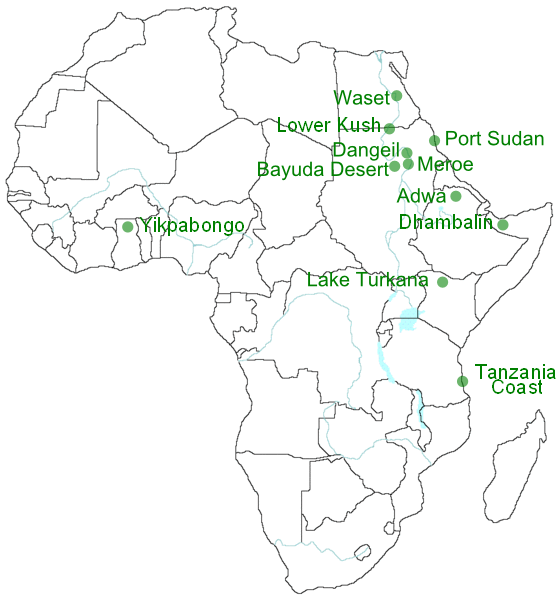Ancient African Archaeological Discoveries
 |
2011
Royal Palace in Meroe Oldest to Date
A recent discovery at Meroe, one of the best known powerful capitals of Kush (also known as "Nubia" or "Ethiopia"), has extended the age of this sub-Saharan African royal city to at least 900 B.C., or over 100 years before the first signs of advanced Greek civilization. The remains of a stone structure described by Royal Ontario Museum archaeologists as a "royal palace", a mudbrick wall, pottery, cattle remains, etc. are now considered to be amongst the oldest evidence of Meroitic civilization. Read More.
Bayuda Desert's Intriguing Petroglyphs
Ancient petroglyphs that date back 5,000 years or earlier found in the Bayuda Desert of Central Sudan provide further links to southern origin of "Western" culture. Although unclear, the rock carvings depict several scenes such as one that appears to be a knight atop a horse that archaeologists have connected to the Christian knight, St. George. It's also important to note the popularity of St. George in this region and his appearance in ancient rock hewn churches in Ethiopia. Read more.
Ancient Prosthesis in Nile Valley Tomb
A wooden big toe on a mummy recently discovered in the ancient capital of Waset (or "Thebes") in Upper (Southern) Kemet is the world's oldest known prosthesis. The find sheds further light on the advanced medical procedures in practice in Africa's Nile Valley, thousands of years prior to use in the West. Read more.
World's Oldest Advanced Stone Tools in Kenya
Sharpened stone tools described by archeaologists on site as "hand axes" found near Lake Turkana in northwest Kenya are now the oldest known advanced stone tools in the world. The tools were dated back to 1.76 million years, over 360,000 years older than those found in Konso, Ethiopia, but still not as old as more primitive tools unearthed in Tanzania's Olduvai gorge. Read more.
Ruins Near Tanzanian Coast
Ruins of yet another Bantu/Swahili city built in the 1200s AD have been found earlier this year along the coast of Tanzania. Home to a host of medieval cities, from Kilwa to Zanzibar, Tanzania was at the center of a major empire that stretched from Mozambique northward to Somalia (which likely included the inland stone cities at Great Zimbabwe, Khami, etc.). Although few details about the new site were provided, the government deems them impressive enough to boost tourism to the developing country in coming years. Read more.
Prehistoric Settlement in Northeastern Sudan
A team of Polish researchers with the Institute of Archaeology and Ethnology uncovered thousands of ancient carvings, terracottas and a cemetery in the highlands near Port Sudan on the Red Sea. This discovery follows that of Krysztof Pluskota's discovery of rock carvings at the site in 1999 and requested further exploration. The team suggests the location of the site near a conical mountain (perceived as a phallic symbol) and myriad images of cattle represent the ancient settlers' emphasis on fertility. Read more.
2010
5,000-Year-Old Rock Art in Somaliland
Over 100 sites with vivid images painted on rocks have been found throughout the Dhambalin region of Somaliland. Among the many finds includes one of the world's oldest depictions of a mounted hunter (similar in age and charateristics to the aforementioned "St. George" petroglyph in the Bayuda Desert). The images also include geometric shapes, and headless people with cattle portrayed in a manner similar to discoveries at the nearby Las Geel rock art sites. Read more.
Kushites Used Tetracycline at Least 1,500 Years Before the West
Bone analyses on the remains of ancient inhabitants of Lower Kush (modern-day Southern Egypt and Northern Sudan) indicate they consumed fermented tetracycline throughout the majority of their lives. The high prevalence of the antibiotic in the bones suggests intentional or medicinal use. The results of the study are significant because tetracycline was only discovered by an American physiologist in 1948 AD. Read more.
Mummified Baboon Links Land of Punt to Eritrea/Ethiopia
An oxygen isotope analysis of hairs on a mummified baboon found in the Valley of Kings in southern Kemet shows a link to baboons only found in Eritrea and Ethiopia. Since ancient Kemetian records indicate baboons were imported from the Land of Punt, the analysis settles the dispute on its specific location in the Eritrea/ Ethiopia region. 18th Dynasty Queen Hatshepsut's tomb recounts a huge trading expedition to the region and other records suggest the Land of Punt was one of Kemet's oldest trading partners. Read more.
Oldest Illustrated Christian Manuscript in Ethiopia
Radiocarbon dating puts a colorful Christian manuscript found in Adwa, Ethiopia's Garima monastery between 330 and 650 AD. Written on goatskin in the ancient Ge'ez language, the so-called Garima Gospels supposedly show the earliest illustrations of Matthew, Mark, Luke, and John as well, as the so-called Temple of Jews. Ethiopian monks have guarded the text, which is believed to have healing powers, in the monastery for over 1,500 years. Read more.
Massive Statues of Taharqa, Others in Dangeil, Sudan
A one-ton statue of the 25th dynasty suten, Taharqa (690 BC), was unearthed in Dangeil, Sudan on the Nile north of Meroe. Other statues of Senkamanisken and Aspelta were also found in the immediate vicinity. The find brings to light the importance of the city at the time of Taharqa's reign, which covered a large portion of the ancient world. Read more.
1,400-Year-Old Statues in Ghana
University of Ghana researchers found nearly 80 ancient sculptures near Yikpabongo, Ghana. The sculptures depict humans and animals, and provide clues about the ancient West African civilizations that existed prior to the spread of Islam. Read more.
Continue >>
